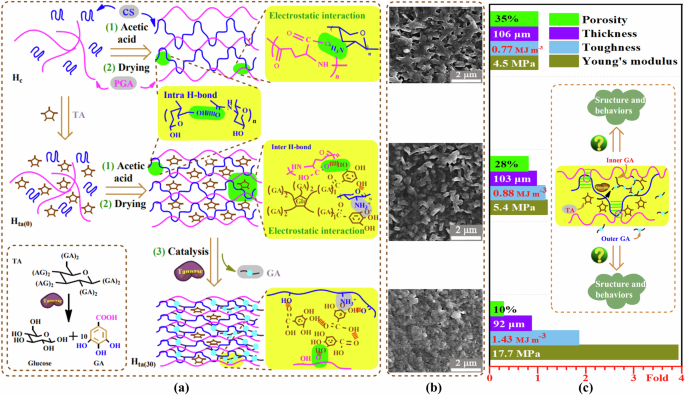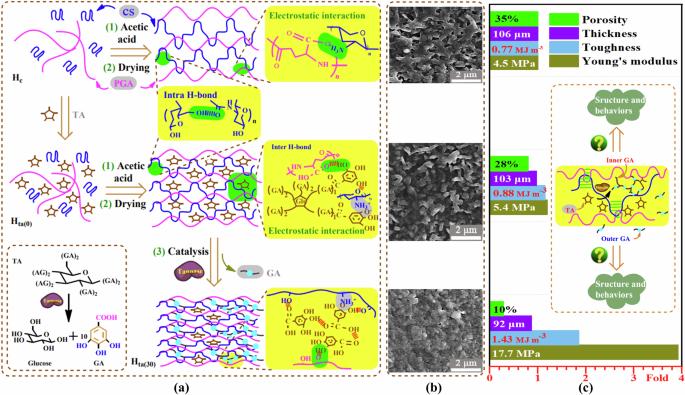Tracking the enzyme-response mechanism of tannic acid-embedded chitosan/γ-polyglutamic acid hydrogel
IF 7.5
Q1 MATERIALS SCIENCE, MULTIDISCIPLINARY
引用次数: 0
Abstract
The design of enzyme-response hydrogels has attracted increasing interest in cell therapy, biomedical research, and tissue engineering. Their rational design usually depends on the enzyme-response mechanism and have focused on behavior improvement, drug delivery, and state transition of hydrogels. However, no enzyme-response mechanism has yet been systematically investigated. Here, we construct a tunable platform of tannic acid-embedded chitosan/γ-polyglutamic acid hydrogel to study the enzyme-response mechanism. We track the roles of gallic acid hydrolyzed from tannic acid in altering the structure and properties of the hydrogel to get insights into the mechanism. The gallic acid inside the hydrogel enhances hydrogel crosslinking, increasing the mechanical properties and pH sensitivity but reducing thickness, porosity, and swelling behavior. The gallic acid outside the hydrogel increases the positive potential and superficial hydrophobicity of the hydrogel. These findings will aid the rational design of other enzyme-response hydrogels in more extensive self-adaptive fields. Understanding enzyme-response mechanisms is important for designing materials in cell therapy, biomedical research, and tissue engineering. Here, a chitosan/γ-polyglutamic acid hydrogel is designed as a platform to understand the role of gallic acid in the enzyme-response mechanism.


跟踪单宁酸嵌入壳聚糖/γ-聚谷氨酸水凝胶的酶反应机制
在细胞治疗、生物医学研究和组织工程学领域,酶反应水凝胶的设计引起了越来越多的关注。水凝胶的合理设计通常取决于酶反应机制,重点关注水凝胶的行为改善、药物输送和状态转换。然而,目前尚未对酶反应机制进行系统研究。在这里,我们构建了一个可调的单宁酸包埋壳聚糖/γ-聚谷氨酸水凝胶平台来研究酶反应机制。我们追踪了从单宁酸中水解出的没食子酸在改变水凝胶结构和性质中的作用,从而深入了解其机理。水凝胶内部的没食子酸增强了水凝胶的交联,提高了机械性能和 pH 值敏感性,但降低了厚度、孔隙率和膨胀行为。而水凝胶外部的没食子酸则会增加水凝胶的正电位和表面疏水性。这些发现将有助于在更广泛的自适应领域合理设计其他酶反应水凝胶。
本文章由计算机程序翻译,如有差异,请以英文原文为准。
求助全文
约1分钟内获得全文
求助全文
来源期刊

Communications Materials
MATERIALS SCIENCE, MULTIDISCIPLINARY-
CiteScore
12.10
自引率
1.30%
发文量
85
审稿时长
17 weeks
期刊介绍:
Communications Materials, a selective open access journal within Nature Portfolio, is dedicated to publishing top-tier research, reviews, and commentary across all facets of materials science. The journal showcases significant advancements in specialized research areas, encompassing both fundamental and applied studies. Serving as an open access option for materials sciences, Communications Materials applies less stringent criteria for impact and significance compared to Nature-branded journals, including Nature Communications.
 求助内容:
求助内容: 应助结果提醒方式:
应助结果提醒方式:


